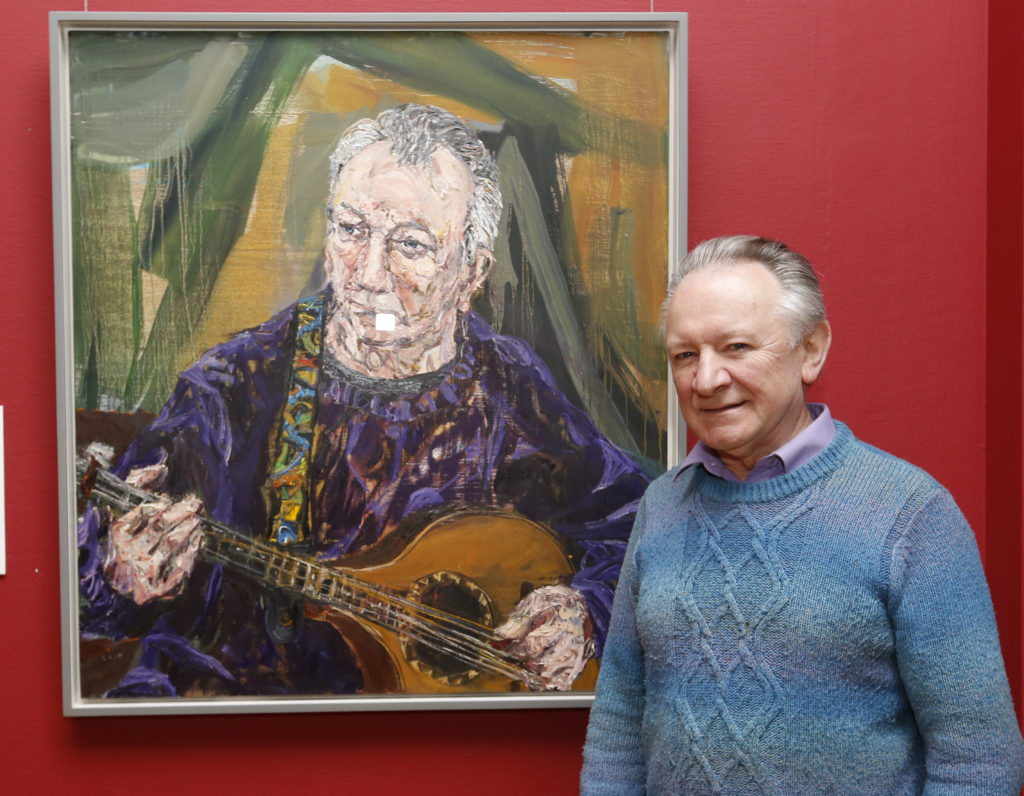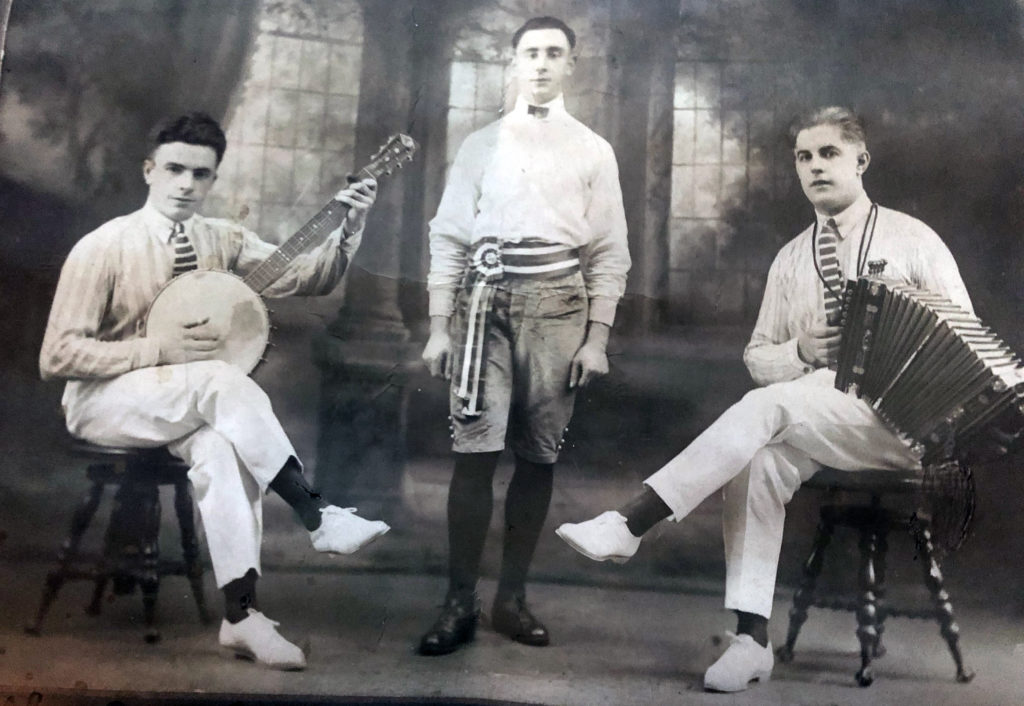The history of fretted instruments in the music of Ireland is a complex one involving three continents, two centuries and multiple musicians. MAL ROGERS delves into the strumming story of the nation
 STRIKING A CHORD Ed Sheeran chats with Co. Down guitar guru George Lowden (picture Getty Images)
STRIKING A CHORD Ed Sheeran chats with Co. Down guitar guru George Lowden (picture Getty Images)BANGOR guitar maker George Lowden has been recognised with a Doctor of the University for distinction in the arts at a special graduation ceremony at Queen’s University Belfast.
The Co. Down man, founder of globally famous Lowden Guitars, was recognised for his significant contribution to society in Northern Ireland and further afield.
A number of world class guitar players own and play Lowden guitars including Eric Clapton, Van Morrison, Mark Knopfler, U2’s The Edge, Paul Brady, Gary Lightbody of Snow Patrol and Niall Horan.
Six string symphony
Today the guitar is an accepted, perhaps even an integral, part of traditional Irish music — it has migrated from rock, jazz, country and classical music to take its role in the folk culture of Ireland.
But it was not ever thus — either for the guitar, or for fretted instruments in general.
It’s impossible to say what the first musical instruments in Ireland were. There is evidence that Neolithic people played some rudimentary type of bone flute; it is possible that the lowly tin whistle resembles the ancient music of Ireland more than any other instrument. It is the simplest imaginable musical instrument. But when you hear it played with soul, the sound is subtle — it is often called the very sound of Ireland. To hear it played sublimely, listen to Mary Bergin.
Contemporaneous to bone flutes, percussion instruments may have been used.
The harp and pipes both made an early appearance, and Irish people struggled on just with these few instruments for centuries.
By the 19th century the fiddle, accordion, piano were being used in Irish music. The 20th century brought a further influx including guitar, mandolin, bouzouki and banjo, all edging their way into the mainstream of Irish music.
Mandolin magic

Most of the large variety of fretted instruments used currently in Irish music only became widely popular in the second half of the 20th century. The eight-stringed mandolin however has been used in Ireland since the early 1900s, although only in the latter years of did it become widespread. The instrument, originating in Italy in the 17th century, became popular in England during the music hall era, soon spreading to Ireland and becoming locally popular with street performers.
The fact that the mandolin’s sound is redolent of the metal strung clarsach (the Irish harp) probably contributed to it being readily co-opted into the service of Irish music, and the instrument slowly edged its way into traditional music circles. Subsequently the instrumental offshoots of the mandolin — the mandocello and the mandola — also began to make an appearance in Irish music.
The top exponent of the mandolin in Irish music today is arguably Simon Mayor. He is one of the leading interpreters of the music of Meath harpist Turlough O’Carolan.
 Donal Lunny in front of Nick Miller's portrait of him (Sasko Lazarov, Rolling News ie)
Donal Lunny in front of Nick Miller's portrait of him (Sasko Lazarov, Rolling News ie)Beware of Greeks bearing a gift
The bouzouki came to Ireland from Greece largely through the efforts of Johnny Moynihan (of Sweeney’s Men and De Dannan), and Andy Irvine of Planxty. Johnny Moynihan is credited with the very first introduction of the instrument into Irish music. According to legend (Irish that is, not ancient Greek), he replaced his mandolin with the Greek instrument, and brought it along to a Sweeney’s Men rehearsal. He was told by Andy Irvine that it sounded awful. “Just forget about it, ffs,” he said.
But the bould Johnny persevered, and eventually converted Andy, and subsequently Donal Lunny, to the delights of the instrument.
At about the same time Alec Finn of De Dannan was mistakenly given a bouzouki by a friend returning from Greece. Apparently Alec had wanted a bottle of ouzo but instead received a bouzouki from his hard of hearing friend.
Whatever the exact means of the appearance of the bouzouki into Irish music, it is certainly due to the combined efforts of Planxty and De Dannan that the instrument has become a fixed feature of the tradition. Today there is perhaps a general feeling that it has more empathy with Irish music than either the piano or the guitar. Hopefully this doesn’t mean that they’ll be asking George Lowden for his honorary degree back.
 IRISH MUSIC PIONEERS Two of the Flanagan Brothers with dance J Grant (Wikimedia Commons)
IRISH MUSIC PIONEERS Two of the Flanagan Brothers with dance J Grant (Wikimedia Commons)Plenty of pluck
The tenor banjo has the longest history of any fretted instrument in Ireland. There is evidence that it may have been played as long as 100 years ago, having been brought to Ireland by travelling minstrel shows. It subsequently became a fairly common instrument in céilí bands from the 1930s onwards.
According to Dr Reg Hall, a noted musicologist, Liam Farrell in London, and Barney McKenna of The Dubliners were the two musicians who hugely popularised the tenor banjo in Irish music. Liam was the first person to introduce it into sessions in England, and is ultimately responsible for its wide adoption.
The tenor banjo is radically different from the five-string banjo used ubiquitously in country music. It’s used in trad jazz, but suits Irish music very well, giving an almost jagged edge to the more mellow and plangent sounds of fiddle, flute, accordion and pipes.
In 1958 Liam arrived in London with his tenor banjo. He’d come to England to work in the building trade — like thousands of other Irish people he was helping rebuild a devastated Britain in the post-war years. He began his British playing career in London with the Hibernian Céilí Band
The efforts of the Pogues, with their ‘céilí-billy’ sound helped re-establish the popularity of the instrument.
Today’s top players include Gerry O’Connor, who has ben describes by the music critic for the Wall Street Journal Earl Hitchener "the single best four string banjoist in the history of Irish Music".

Four strings good, five strings even better
The five string banjo is a truly cosmopolitan affair. It probably first came to America from Africa, where a rudimentary form of the instrument was known as the banjar. It was subsequently used in the various cultures of the southern states of America - bluegrass, country, blues, jazz and gospel.
Originally the instrument had four strings but possibly received its fifth string from Irish settlers in the Appalachian or Ozark regions of the southern States, in an atavistic effort to recapture the droning sound of the fiddle or the pipes the immigrants had left back home in Ireland. The banjo subsequently made the journey back across the Atlantic to Ireland, but never really attained the popularity that it enjoys to this day in the States.
The five string banjo is not primarily an instrument for playing melody, not being tuned to facilitate this. It is, like the guitar, mainly used for providing chord accompaniment. The instrument was first made popular in Ireland by Tommy Makem of the Clancys, who heard it being played in America. It was soon adopted by Luke Kelly and with the increasing success of both the Dubliners and the Clancys its popularity quickly spread.
Today the banjo has somewhat lost ground to the other fretted instruments. But to many it is an irreplaceable part of the tradition.
 Liam Farrell
Liam FarrellThe axeman cometh
The guitar, a part of the lute family, has its origins in 15th century Spain. Its journey to being used in blues, jazz, skiffle and finally rock music is a convoluted one. With the Spanish colonisation of South America the guitar arrived on the other side of the Atlantic. Its long evolution to becoming one of the most ubiquitous instruments in the world had begun.
In Ireland, the Fureys in Dublin and the McPeakes in Belfast, in the 1960s, were the first to play guitars alongside the uilleann pipes — a revolutionary step — and were among the early pioneers using guitars at all in Irish folk music.
The Dubliners deserve huge recognition for taking traditional reels and jigs and backing Barney McKenna’s tenor banjo and John Sheahan’s fiddle with guitar.
But none of these were the first to introduce the guitar into traditional Irish music. That step almost certainly happened in America, and the honour in all likelihood goes to the Flanagan Brothers, back in the 1920s.
The Flanagans were a trio from Waterford. Michael, Joseph and Louis, like so many other Irish people in that era, had found a new life for themselves in New York. Joe played accordion, Mick played banjo and Louis the guitar. This truly was the prototype Irish band.
The Flanagans contribution to Irish music has been forgotten — just like the Fureys and the McPeakes they have largely been written out of the official story of Irish music. Certainly, the guitar became popular for song accompaniment largely through the efforts of the Clancy Brothers and The Dubliners. These two bands, although not the first to use the guitar in Irish music, made it a ubiquitous part of the tradition.
Arguably, two musicians took the instrument to its greatest heights. Paul Brady’s brilliance on the guitar is often overlooked because of his first class singing. But Brady could hold his own with the top session guitarists anywhere. Similarly, Denis Cahill — who was long associated with fiddler Martin Hayes — is generally regarded as having taken guitar playing in Irish music to a new level. Sadly, the Chicago man died in 2022.

